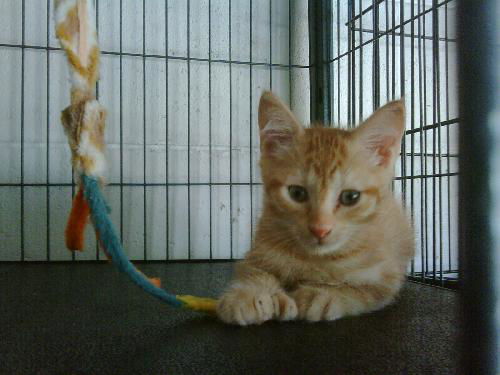Domestic Short Hair (short coat) : : Male (neutered) : : Baby : : Medium
Because of the difficulty getting appointments to get our rescue cats altered in a timely manner, we recently launched our pre-spay/neuter adoption program. The cat you are interested in may be part of this program and will have at least it’s first FVRCP vaccine, a microchip registered to us and will have been treated for internal and external parasites. Please fill out our screening form and after reviewing and confirming your information, our adoption counselor will reach out to you to explain the process.
Guarionex is the sweetest kitten. He is very special and he will need a home were he can be safe from harms way. He is being diagnose with Cerebellar Hypoplesia. He is perfectly healty, he can just not coordinate his movement well and looses balance. Read more about his condition below to be able to understand him. Once you get to hold him you will understand why he is so special. We would love to see him get adopted with his sister Yahima. Which is being with him all this time and they are very close. Did I mention that Guarionex and his sister has extra toes. He has 6 and Yahima has 7 yeap lots of toes :-) CEREBELLAR HYPOPLASIA The cat with cerebellar hypoplasia is abnormal from birth, though it may not be clear that something is wrong until the kittens are toddling around with some coordination. The cat with this disease clearly has balance issues: he walks with his legs widely placed for fear of falling and places his feet clumsily. He often leans against walls for support. Sitting still, he may look like a fairly normal cat but once focused on a toy, food bowl or friendly hand, tremors begin getting more severe as concentration becomes more intense. Still, despite the obvious impairment, cats with this condition are happy, able to feed themselves and use a litter box, and are felt to have good life quality. YOUR CEREBELLUM AND YOU
The cerebellum is part of the central nervous system though not exactly part of the brain. It is nestled inside your skull at the base of the brain as shown in this picture. The cerebellum is involved in the involuntary aspects of moving our bodies, whether we are walking around, reaching for something, or just turning our heads. These all seem like voluntary activities so it might be difficult to consider that there is something involuntary going on as well. Still, consider walking across an uneven perhaps rocky terrain while carrying on a conversation with another person. Certainly the decision to move from point A to point B is voluntary but the chances are you can walk across pretty uneven terrain without falling down or even thinking about where to put your feet. You can thank your cerebellum for that. Your cerebellum receives information from your feet as well as from the vestibular apparatus in your middle ear. This information tells you where up and down are and where your body is in relation to up and down. Your cerebellum integrates all this information so that you can not only walk or run across uneven terrain without devoting any conscious thought to how to do so, you can turn your head, maybe even drink from a bottle of water, and look at another person while you are walking without (much) chance of falling down. YOUR CAT’S CEREBELLUM AND THE FELINE DISTEMPER VIRUS The cerebellum is obviously a complex piece of equipment. During development before birth, the cerebellum is maturing up until the last few days before birth. Having a long period of development leaves the cerebellum especially vulnerable to an assortment of toxins for a long period of time. In the case of cerebellar hypoplasia the culprit is the feline distemper virus. Growing nerves in the cerebellum are destroyed ultimately yielding a tiny improperly developed cerebellum and a disability in the kitten. The mother cat need not be actually infected during pregnancy to create this syndrome; she can simply be vaccinated with a modified live distemper vaccine, the most basic of all cat vaccines. Kittens infected with distemper under age 2 weeks may also experience This means that mother cats due for vaccines should not be vaccinated DIAGNOSIS While special imaging such as CT scanning or MRI can be used to confirm the underdeveloped tiny cerebellum, the diagnosis of this condition is usually obvious because of the following features:
The internet is rife with video shot by owners of “CH” cats. Here is a video of kittens showing the typical clinical signs (click on the “play” arrow to play video):
TREATMENT No treatment can resolve the damage in a kitten with cerebellar hypoplasia. Some kittens are more severely affected than others. Owning a cat with cerebellar hypoplasia emphasizes managing the condition. The cat should be indoors only and non-spill food dishes should be obtained. Most cats have good life quality and make up in personality what they lack in motor skills. Some on-line communities have sprung up for owners of cats with cerebellar hypoplasia. Here are two areas that might be of interest. http://community.livejournal.com/ch_kitties/www.chkittyclub.com/pages/home.html
PREVENTION This syndrome is easily prevented by vaccinating female cats for feline distemper when they are not pregnant. This means that regular vaccination will prevent cerebellar hypoplasia in kittens. If a cat is pregnant, vaccination should be withheld during pregnancy and for a good 2-3 weeks after the kittens are born.
Page posted: 1/17/08 More about GUARIONEX (LR)Good with Cats GUARIONEX (LR) must be adopted with his sister, YAHIMA (LR) (adopted).
Other Pictures of GUARIONEX (LR) (click to see larger version):
|
|||||||||||||












